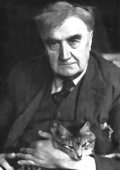
Ralph Vaughan-Williams
A 20th century English composer, Ralph Vaughan-Williams is something of an anomaly. The 20th century was a time of musical diversity, with a thousand different composers going in a thousand different directions. Many 20th century composers were influenced by politics, or world events. Shostakovich's 7th Symphony, 'Leningrad,' was written during, and inspired by the siege of Leningrad.
Composers like Paul Hindemith and Bela Bartók were using a new type of tonal language, and serialism and atonality were driving forces in this time too.
Yet Vaughan-Williams chose to write his music in what could be termed a "traditional" way. His music remained virtually unchanged by the world in which it was composed, despite those around him continually trying to affix programmatic meanings to such works as the 4th symphony, a stormy, angry sounding piece written in 1934. His music was written on a purely emotional basis, and it is with that in mind, we look into his 5th symphony.
The 5th symphony in D was derived from bits of an abandoned opera called The Pilgrim's Progress (the opera was later completed), which was inspired by the literary work by John Bunyan. Although the symphony is labeled in D, it actually starts off in the key of C, creating an air of expectation. The symphony opens with a soothing prelude. While the following scherzo is rambunctious, the overall placid quality is left intact with just a few ripples in it.
The scherzo is succeeded with a gorgeous romance that is among the most beautiful pieces of music ever written, and a satisfying and jubilant finale termed a passacaglia (a form in which a single theme reoccurs many times, and that forms the structure of the movement), in which the key of D is finally reached.
Although some historians have even tried to label this symphony as an "anti-war" symphony, because of its peaceable sound, and the year it was published (1943), and as you listen to the music itself you can imagine the various trials of the pilgrim (and some music historians have done just that), if you take the music on a purely music basis without extra-musical references in mind, you are left with a powerfully emotional masterpiece.

Thomas Tallis
Added to this masterpiece, is the great work for string orchestra Fantasia on a Theme by Thomas Tallis. Scored for string orchestra, chamber string orchestra, and string quartet, really sounds more like a chamber work then an orchestral piece. Written in 1910 at a time when Vaughan-Williams was busily editing the New English Hymnal, he found one of the hymns by Tallis, and worked one of the themes in it with some of his own creation into a fantasia (the first theme in pizzicato lower strings is Tallis' theme).
Vaughan-Williams uses the various levels of the string orchestra brilliantly, juxtaposing the chamber sounds of the smaller chamber orchestra with the massive sounds of the full string orchestra, and at times even exposing a single plaintive voice (at one time the viola, at another, the violin) to make a simple statement.
Such passionate music requires musicians of the utmost excellence, and Andre Previn leads the Royal Philharmonic Orchestra admirably in this set, which is well mastered for the passionate side of Vaughan-Williams by Telarc with a smooth sheen that leaves the message of the music undisrupted.
It would be foolish to call this "calm" Vaughan-Williams though. This is Vaughan-Williams at his most passionate, and if you like Vaughan-Williams, you cannot afford to be without this disc. If you don't, I can't recommend a better disc to start with.
Please support Good-Music-Guide.com
by purchasing this CD using this link.

Track Listing
Ralph Vaughan-Williams
Symphony No.5
Fantasia on Theme by Thomas Tallis
Royal Philharmonic Orchestra
Andre Previn
Symphony No.5 in D major
- Preludio: Moderato
- Scherzo: Presto Misterioso
- Romanza: Lento
- Passacaglia: Moderato
- Fantasia On A Theme By Thomas Tallis